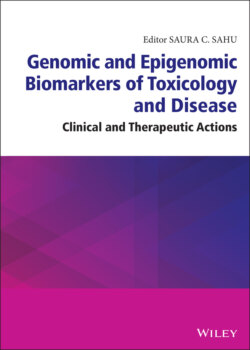Читать книгу Genomic and Epigenomic Biomarkers of Toxicology and Disease - Группа авторов - Страница 28
Application
ОглавлениеThe potential utility of miRNAs extends beyond their role as biomarkers of environmental toxicant exposure, encompassing applications in quantitative chemical risk assessment and in clinical diagnostics and therapeutics. Multiple studies have shown that the transcriptional benchmark dose modeling (BMD) of short-term chemical exposures can generate point-of-departure (POD) values or “breaking points” of chemical exposure that lead to disease or other adverse outcomes of regulatory concern. These next-generation toxicological assessments that use molecular measurements are consistent with traditional, longer-term apical endpoints and can inform the mode of action (MOA) via which the exposure imparts adverse outcomes (Lake et al. 2016; Thomas et al. 2007; Webster et al. 2015). The hepatic cell culture model, HepaRG, has been successfully leveraged for high-throughput transcriptomic studies that examine concentration–response relationships in order to predict liver injury (Ramaiahgari et al. 2019). Fewer studies have applied BMD assessments to miRNA expression levels but, because dysregulation of a small number of miRNAs can impact hundreds of gene targets, assessing miRNAs could reduce the complexity and variability associated with mRNA biomarkers. Rager et al. (2017) modeled multiple molecular endpoints from human cord blood after prenatal exposure to inorganic arsenic, including mRNA expression, protein expression, miRNA expression and DNA (CpG) methylation. They found twelve miRNAs significantly associated with exposure. The BMD values were 33 µg As/L urine (maternal exposure) for CpG methylation, 42 µg/L for miRNA, 45 µg/L for protein and 64 µg/L for mRNA. Interestingly, it was the epigenetic markers (including the miRNAs) that established the most conservative BMD values. Nevertheless, all endpoints reflected the epidemiological evidence of prenatal effects of inorganic arsenicals, all of which occurred below 100 µg/L urine. Stermer et al. (2019) used BMD-modeled miRNA sequencing reads and other small RNA molecular measurements of toxicity in rat sperm after exposure to the testicular toxicant ethylene glycol monomethyl ether (EMGE) and found them to be sensitive and predictive biomarkers of exposure. Calculations resulted in a BMD of 62 mg/kg using retained spermatid head (RSH), whereas percent miRNA resulted in a BMD of 59.2 mg/kg. A recent study in our laboratory (Chorley et al. 2020) indicated that miRNAs measured from mouse liver in response to DEHP exposure display early dose-responsive patterns linked to the predominant signaling pathway (PPARα); however, the BMD estimates based on these miRNAs were higher than for the target genes (163 vs 74 mg/kg-day). By contrast, another ongoing study sequenced miRNAs in liver tissue from B6C3F1 mice exposed to the rodent liver tumorigen furan and reported a mean miRNA BMD of 2.0 mg/kg/day, which was in close agreement with the 2-year determinations of hepatocyte cellular adenoma and human cellular carcinoma (HCA + HCC) BMD values of 2.3 mg/kg/day and more conservative than the most sensitive messenger RNA BMD of 2.8 mg/kg/day. miR-122 was also increased in the blood of treated mice (BMD 1.4 mg/kg/day). Overall, these studies indicate the potential usefulness of miRNA measurement in blood, tissue, and cell culture for quantitative risk assessment. Additional case studies are needed to examine a broad range of chemical MOA and whether the presence of these biomarkers in biofluids can consistently establish POD values reflective of cellular and tissue perturbation.
Clinical applications for miRNA biomarkers in biofluids are showing recent growth. In addition to their use in drug screening for DILI and drug-induced kidney injury (DIKI), they are finding utility as diagnostic and prognostic biomarkers for disease. A number of recent reviews have summarized the current miRNA diagnostic and therapeutic landscape (Bonneau et al. 2019; Chakraborty et al. 2021; Condrat et al. 2020; Hanna et al. 2019; Vandana Saini, 2021; Tribolet et al. 2020). These biomarkers can be used to indicate the presence of a pathology, or even the stage, progression, or genetic link of pathogenesis (Hanna et al. 2019). In certain situations, one miRNA biomarker may be sufficient to identify a health outcome; but more often a well-defined panel of miRNAs is necessary for increased diagnostic sensitivity or specificity. Despite the advantages of miRNA biomarkers for early detection, improved pathogen identification and personalized medicine, their translation from the research bench into the clinic has been slow. Many companies are successfully developing diagnostic miRNA panels and several products are already available to clinicians (Bonneau et al. 2019; Vandana Saini et al. 2021). In 2012, Rosetta Genomics in partnership with Precision Therapeutics launched miRview™ mets, a miRNA panel measuring the expression levels of sixty-four miRNAs that allow the identification of cancers of unknown or uncertain primary origin (CUPs), which account for up to 15% of newly diagnosed cancer cases in the United States every year. Interpace Diagnostics/Asuragen offers a product for the diagnosis of thyroid cancer that combines ThyraMIR®, a miRNA classifier including the quantification of 10 miRNAs, and ThyGeNEXT®, an oncogene panel for thyroid cancer stratification. This combination offers an interesting alternative to standard cytological evaluations, which fail to discriminate benign from malignant lesions in 15–30% of cases. In November 2018, the Blue Cross Blue Shield and the US Federal Employee Health Benefit Program agreed to include the ThyGeNEXT®/ThyraMIR® combined tests for their beneficiaries. TAmiRNA markets OsteomiR™, a product measuring the expression level of 19 blood-circulating miRNAs intended to calculate the risk of a first fracture in female patients with postmenopausal osteoporosis and type-2 diabetes. Similarly, TAmiRNA also provides the ThrombomiR™ panel (11 miRNAs), so as to assess platelet function in cardiovascular disease. In addition, miRNA-based therapeutics—including miRNA mimics or antagonists targeting miRNAs involved in hepatitis C, fibrosis, T-cell lymphoma, heart failure, mesothelioma, and ulcerative colitis—are in various phases of clinical trials (Vandana Saini et al. 2021).
